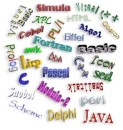

Science makes it known,
Engineering makes it work,
Art makes it beautiful.

COBOL, D, FORTRAN, Lazarus, and Pascal Tutorials;
COBOL, D, FORTRAN, Lazarus, Pascal, and Basic Downloads1
(This page presumes the user is an experienced programmer, knowledgeable with multiple programming languages and operating systems. It also requires familiarity with unzipping programs, installing software, and directory structures. Experience with multiple platforms would be helpful as well.)
|
What Is COBOL?
The Future of COBOL COBOL: Everywhere and Nowhere Free COBOL Compilers and Interpreters |
Free Fortran Compilers
Free D Compilers and Interpreters Free Pascal Compilers and Interpreters |
Each programming language has its own strengths and
The COBOL tutorials and downloads on this page have been developed using and/or for the (previously) free Fujitsu COBOL 3.0/PowerCOBOL 3.0 student compilers executing on a Win32
The D 4, FORTRAN, Object Pascal, Lazarus (Delphi compatible), and XBLite development tools (XBLite, Lazarus, Free Pascal, Silverfrost FTN95, and Digital Mars D Compiler) used for these tutorials are still freely available (Silverfrost FTN95 free for
In these tutorials, two FORTRAN backends are used - sttstcs.for and mathproc.for. Object Pascal is used for both frontends and backends. COBOL and Lazarus are used for frontends. D is used for both.
Inter-Program Mixed-Language calling considerations:
-
Variable Storage Compatibility and Equivalence
(Character vs Integer vs Short vs Float vs Complex;
variable's Word Size) - elements of
Inter-Program Communications; character data and complex variables can be special cases -
Array Compatibility
(A special case of
Variable Storage Compatibility and Equivalence
above) - indexing, dimensioning, row major or column major. See also
IC-POINT-ARRAY and
IC-POINT-ARRAY-REDEF in COBOL Files - COBOL 3.0, PowerCOBOL 3.0, Silverfrost FTN95, and Numerical Recipes and Pascal Arrays. - Case Sensitivity (may affect compiler options) C, C++, D, and XBLite (XBasic Lite) are case sensitive; COBOL, FORTRAN, and Pascal are case insensitive - variable/subprogram name lower case letters may be automatically converted to upper case; D's extern (Pascal) {...} can affect case sensitivity
- Variables passed By Reference (basically, variable's address passed; address unmodifiable), By Value (subprogram uses a local copy), or By Pointer (variable's address passed; address modifiable). XBLite is an example of a language that can pass parameters by all three methods. C uses By Value and By Pointer; Pascal and Lazarus By Value and By Reference; FORTRAN defaults to By Reference.
- Calling Model (Standard Call vs cdecl; other calling mechanisms include register, interrupt, pascal, safecall, and oldfpccall)
-
The order the passed arguments are Pushed/Popped to/from the stack
(sometimes called passed
left-to-right orright-to-left). This is one of several considerations in both D calling FORTRAN and D calling Pascal. - Function/Procedure/Subroutine name mangling - some programming languages/compilers will mangle a subprogram's name internally (.lib file and .dll file), though any source code written for that programming language/compiler can refer to the unmangled name. For example, the DMD D compiler will mangle procedure name hEditInitMsg(...) to D6hedtio12hEditInitMsgFNbPvZv (...). Use Dependency Walker to determine a procedure's mangled name (if any).
- Import Libraries - some compilers require an import library (*.lib) while others do not. Two incompatible formats are used - COFF and Intel 32 bit OMF. Fujitsu COBOL (and XBLite via GoAsm & Linker) generates and requires Microsoft 32 bit Linker compatible COFF import libraries, Silverfrost FTN95 SLINK can generate Microsoft 32 bit Linker compatible COFF import libraries. Digital Mars D compiler generates and requires Intel 32 bit OMF import libraries (fortunately, they supply a free utility, implib, to generate an OMF import library from a *.dll). Free Pascal and Lazarus do not require import libraries.
Tutorials
COBOL Program Structure and Elements:
Structure, keywords, data definition, and executable statements of a COBOL
program.
FORTRAN Program Structure and Elements:
Layout, keywords, specification statements, and executable statements of a
FORTRAN program.5
Pascal Program Structure and Elements:
Covers Pascal Main Programs, Pascal Units, Lazarus Object Pascal Units, and
Object Pascal Libraries.5
Appending Text to Windows Edit Control:
done on the Windows API level, written in Object Pascal; should be
able to port the Win32 API calls to other programming languages.
Includes downloads of Object Pascal Library source files, compiling
instructions, code snippets of showing how to use.
Using Lazarus Tab Sheets (TPageControl & TTabSheet):
Uses a real world example of calculating Coefficients of Normal Force and
Centers of Pressure for a
These tutorials and downloads are strictly for the Win32 platform (Win98, WinXP, Win7).
These tutorials detail D procedures/programs calling FORTRAN functions/subprograms/subroutines, D procedures/programs calling Object Pascal functions/procedures, Object Pascal programs/procedures calling D functions/procedures, Object Pascal programs/procedures calling FORTRAN
COBOL calling FORTRAN .dll:
Interfacing COBOL with a Silverfrost FTN95 FORTRAN .dll (This example demonstrates combining computation strengths of FORTRAN with the data input/output strengths of COBOL):
- Overview - Combining Fujitsu COBOL 3.0, PowerCOBOL 3.0, Silverfrost FTN95, and Numerical Recipes: The Art of Scientific Computing : Using a COBOL "wrapper" around FORTRAN subroutines to calculate Average, Median, Standard Deviation, and Variance (Statistics Analysis).
- COBOL Files - Combining Fujitsu COBOL 3.0, PowerCOBOL 3.0, Silverfrost FTN95, and Numerical Recipes: The Art of Scientific Computing : The COBOL "wrapper" - source files, compiling, and linking. Includes downloads of some COBOL source files.
- FORTRAN File - Combining Fujitsu COBOL 3.0, PowerCOBOL 3.0, Silverfrost FTN95, and Numerical Recipes: The Art of Scientific Computing (Statistics Analysis) : The FORTRAN backend (sttstcs.dll) - source file, compiling, and linking. sttstcs.dll is used in multiple projects.
COBOL calling C++ .dll:
Interfacing COBOL with a C++ .dll (This example demonstrates interfacing with a third party application, the USPS Address Matching System API; USPS AMS API source code unavailable, only import library and dynamic link library available - often a common situation when using commercial third party libraries):
-
Using Fujitsu COBOL 3.0 to call the USPS Address Matching System API (USPS AMS API)
: Describes how to call C++ functions
from a COBOL main program on the
Win32
platform. Uses the Fujitsu COBOL 3.0 compiler and the USPS AMS API as anexample. Shows how to define the AMS API ZIP4_PARM C++ struct as a COBOL record (can be downloadedbelow). Includes compiling and linking options. -
Combining Fujitsu COBOL 3.0, PowerCOBOL 3.0, and the USPS Address Matching System API
: Describes
one solution to interfacing a Fujitsu PowerCOBOL 3.0 GUI application with a
C++ library on the Win32
platform. This is a practical application of the Using Fujitsu COBOL 3.0 to call the USPS Address Matching System API (USPS AMS API) tutorialabove. Includes compiling and linkingoptions. This example demonstrates combining COBOL's file processing strengths with a third party API. Includes downloads of many COBOL source files.
These tutorials detail D programs calling subprograms written in other programming languages
D main program calling FORTRAN .dll:
Interfacing D programming language main program with a Silverfrost FTN95 FORTRAN .dll (This example demonstrates combining computation strengths of FORTRAN with the general purpose systems and applications programming language D):
- D Programming Language, Silverfrost Fortran 95, and Numerical Recipes : Describes how to call FORTRAN subprograms using a simple command line Digital Mars D main program. Differences between D, Pascal, and FORTRAN arrays and matrices, using D extern statements, and passing parameters.
- D Windows program, Silverfrost Fortran 95, and Numerical Recipes : Describes how to call FORTRAN subprograms in a Windows program written in D. Includes downloads of the D source files.
- FORTRAN File - Combining Digital Mars D main program, Silverfrost FTN95, and Numerical Recipes: The Art of Scientific Computing (Statistics Analysis) : The FORTRAN backend - source file, compiling, and linking. This is the same FORTRAN sttstcs.dll used in COBOL calling FORTRAN .dll.
D .dll calling FORTRAN .dll:
Using a D .dll to call subprograms in a FORTRAN .dll is somewhat more complex. This example also examines constructing a D .dll as well as a D interface file. Using Simulated Annealing from Numerical Recipes: The Art of Scientific Computing, it also demonstrates how to do an application staged migration from one programming language to another:
- D .dll, Silverfrost Fortran 95, and Numerical Recipes : Some pointers of writing D .dll's, D interface files, and calling FORTRAN subprograms from a D .dll. Compiling and linking the D .dll. Includes downloads of the D source files.
- FORTRAN FILE - D .dll, Silverfrost Fortran 95, and Numerical Recipes (Simulated Annealing) : mathproc.dll - the FORTRAN backend - source file, compiling, and linking. mathproc.dll contains engineering, mathematic, and scientific subprograms, used in several projects.
D main program calling Object Pascal .dll:
Interfacing D programming language main program with a Free Pascal Pascal .dll. This is somewhat easier than D calling FORTRAN:
- D Programming Language, Free Pascal, and Financial Functions : Describes how to call Pascal functions and procedures using a simple command line Digital Mars D main program. D extern statements, data type equivalency, passing parameters By Reference or By Value, cdecl, and stdcall.
- Pascal File - D Programming Language, Free Pascal, and Financial Functions : Sample Pascal backend - source file, compiling, linking, side effects of D's extern (Pascal) {...}, and import library creation. Includes downloads of source file and .bat file to compile source file.
D .dll calling Object Pascal .dll:
Demonstrates several concepts - command line parameter parsing; software reuse; D .dll calling Object
- D .dll Calling Free Pascal .dll - D Files : Command Line Parameter Parsing D module CmdLine front end; pragma statements. Includes download of D module source files.
- D .dll Calling Free Pascal .dll - Pascal Files : Command Line Parameter Parsing Object Pascal Library ALlazrs back end; import library creation. Includes downloads of Pascal source files.
D calling XBasic Lite :
Covers using D's extern (C) {...}, XBLite's CFUNCTION, limitations of passing parameters to XBLite, compiling, and linking (implib /system switch):
- D main program calling XBLite Library : D command console program calling XBLite elliptical functions; brief introduction/demonstration of hypergeometric functions. Includes download of XBasic source file, listing of D program.
Tutorials demonstrating Object Pascal and Lazarus employing FORTRAN's mathematical capabilities. Free Pascal programs do not crash (unlike D) calling FORTRAN subprograms that use eX functions [EXP(), SINH(), etc.]. However, Pascal does not support complex variables. Overall, Pascal should be better able than D of making use of extensive FORTRAN engineering and scientific libraries. These pages are often updated - primarily downloadable source code enhancements, corrections, and improved explanations.
Object Pascal Programs calling FORTRAN .dll:
Using Free Pascal to call subprograms in a FORTRAN .dll (sttstcs.dll, Statistics Analysis .dll used by both COBOL and D; and mathproc.dll, Simulated Annealing .dll used above) - the easiest for linking:
- Command line Free Pascal and Silverfrost Fortran 95 : Describes how to call FORTRAN subprograms using Pascal command console programs, including passing arrays. Includes download of sample Pascal program.
- Simple Free Pascal Windows Program, Pascal Library, DMD D, and Silverfrost Fortran 95 : Describes how to call FORTRAN Functions (NROOT (...) in sttstcs.dll) as well as D procedures (hEditInitMsg(...) in module hedtio) using its D mangled name from a Pascal Windows program. Using Dependency Walker to find a procedure's mangled name. Calling a D function declared extern (C). Includes downloads of sample Pascal program, Pascal Library, FORTRAN Function, and D module.
- Pascal .dll calling FORTRAN engineering subroutines in mathproc.dll : Uses an example of calculating rocket Coefficients of Normal Force and Centers of Pressure (also has brief introduction to rocket stability) to demonstrate Pascal .dll calling FORTRAN. Includes downloads of Pascal Library (missle02.dll) and FORTRAN subprograms extracted from mathproc.dll. (The download source files are being regularly enhanced. New versions will be uploaded as they are completed.)
Lazarus Programs calling FORTRAN .dll:
Lazarus (Delphi compatible) calling FORTRAN subprograms via a Free Pascal .dll. (These examples represents combining a Rapid Application Development Tool with a time proven .dll):
- Lazarus, Free Pascal, Silverfrost FTN95, and Numerical Recipes: The Art of Scientific Computing : This is basically an updated, enhanced, and more functional implementation of STF95COB. Like Fujitsu PowerCOBOL 3.0, Lazarus is event driven programming and can present data in table form. Where Fujitsu COBOL 3.0 programs need an interface subprogram (INVKSHT.COB and F5BBRUNS.DLL) to use PowerCOBOL sheets, Lazarus program ST95DLPH needs an user written Free Pascal LIBRARY nrlazrs procedure rMoment (...) to call the Numerical Recipes FORTRAN subprograms. Includes downloads of Lazarus program source files, Pascal Library, and include files.
- FORTRAN File - Silverfrost FTN95 and Numerical Recipes: The Art of Scientific Computing (Statistics Analysis) : The FORTRAN backend - source file, compiling, and linking. While this is the same FORTRAN sttstcs.dll used in COBOL calling FORTRAN .dll, different subprograms, AVEVAR (...) and MDIAN2 (...), are called.
- Lazarus Sub-forms, Grid Cell Background Color, StringGrid Cell Editor, and Calling FORTRAN : Introduction to Lazarus sub-forms; changing the cell background color in a TStringGrid; using a cbsEllipsis Editor Style in a TStringGrid; and Lazarus calling FORTRAN via Object Pascal .dll. Part of an actual application to input and analyze a model rocket design. Uses Pascal missle02.dll (see above) to call mathproc.dll FORTRAN subprograms and Pascal nrlazrs.dll (see above) to call sttstcs.dll FORTRAN subprograms.
-
Lazarus Sub-forms, Calling FORTRAN, Software Re-use, and Aerodynamics
: Another example of Lazarus sub-forms and calling FORTRAN via Object
Pascal. Detailed example of software re-use. Part of an actual
application to input and analyze model rocket design - adding
Parallel Stages to a rocket's launch configuration. Via Object Pascal,
calls FORTRAN subroutines to
calculate parallel stage surface area and estimate impact on Coefficient of
Normal Force and Center of Pressure.
(Many of the download source files are regularly enhanced. New versions will be uploaded as they are completed.)
Additional Downloads
USPS AMS API C struct ZIP4_PARM translated to COBOL Record layout
: As
described
in the
Using Fujitsu COBOL 3.0 to call the USPS Address Matching System API
tutorial
COBOL Line Numbering Utility
:
An extremely simple COBOL source file line number manipulation utility that
can be downloaded
and modified (includes source code, written in Visual Basic 2.0). Runs
on both Win16 and Win32 platforms (pre Win Vista) (if anyone upgrades this
to a later version of VB, please
email
to me).
Silverfrost Fortran 95 subprogram to compute Nth Root of X
:
FORTRAN function (including source code) to compute
Miscellaneous mathematical subprograms in mathproc.dll
:
FORTRAN functions and subroutines (including source code) for Point Rotation,
1. Many of the downloadable source files are enhanced regularly. Some may contain developmental and/or experimental code. The source files are distributed in the hope that they will be useful, but WITHOUT ANY WARRANTY; without even the implied warranty of MERCHANTABILITY or FITNESS FOR A PARTICULAR PURPOSE. Depending on your O/S, some may require VMware.
2. You may be able to find the free student compiler installation file in a web search. The name of the install file is COBOLV3.EXE, 11,740 KB (or 11,739 KB). Any other size may contain malware.
Currently Fujitsu NetCOBOL® is distributed by GT Software
3. Earlier versions of Lazarus also had this limitation. See WinXP Command Prompt Path for additional details on short file names vs. long file names. While have not tried it in a PowerCOBOL application, it should work.
4. D was designed to be both C like and a replacement for C++. The designers wanted to eliminate many of the backwards compatibility issues of C++. Using 32-bit D version 2.0.066 compiler.
5. Thanks to Prof. John H. Mathews, Department of Mathematics, California State University Fullerton for some of the material.

